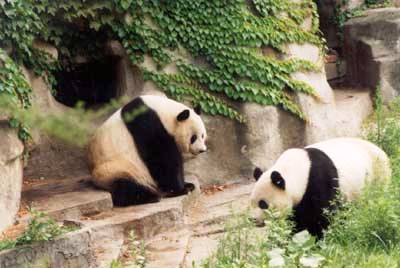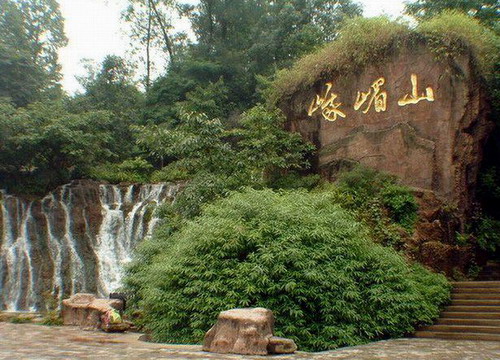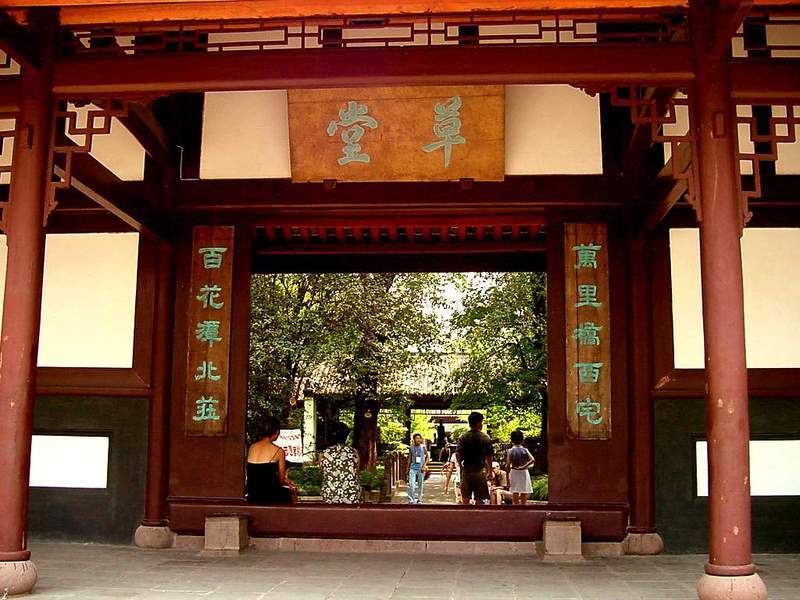Great Buddha at Leshan

Leshan Giant Buddha is one of the most magnificent tourist attractions in Sichuan Province . It's located on the Westside of Xiluan Peak ( Phoenix Perched Peak ) of Mount Lingyun , just east of Leshan City . Overlooking the confluence of the Minjiang, Qingyi and Dadu rivers, the Buddha is carved into the cliffs of Mt. Lingyun . A local saying describes the Buddha like this; "The mountain unveils a Buddha, while the Buddha fades into the mountain."
The huge figure takes the shape of a Maitreya Buddha, a disciple of Sakyamuni, the founder of Buddhism. The figure occupies the entire hillside. Its head reaches the top of the cliffs, his hands rest on his knees and his face has a serene expression as it gazes at Leshan city across the river which rushes past its feet.
Looking solemn and stately, the Buddha is 71 meters high. His shoulders are 28 meters wide, head 14.7 metes long and 10 meters broad, with a total of 1021 chignons of hair clustered on it. Each is as big as a round table. Its drooping ear is 6.2 meters long, its eye 3.3 meters wide. Its middle finger is 8.3 meters long, and each of its bare feet are 11 meters long and 8.5 meters wide, large enough for more than 100 people to sit on.
As a colossal statue the Buddha is so awe-inspiring that every pious Buddhist feels compelled to fall to his knees and to pray for blessings and safety in life.
The Leshan Giant Buddha is taller by 18 meters than the standing Buddha in Afghanistan , which were badly damaged by in 2001 and is believed to be the world's largest and tallest sculpture of a Buddha carved in rock. In 1996, it was added to the World Natural and Cultural Heritage List.
According to records, the carving of this massive statue began in 713AD, during the Tang dynasty, and took 90 years to complete, finally being finished in 803AD.
The Leshan Buddha has suffered from hundreds of years of erosion by atmospheric moisture and water running off from the mountain. Water retained on the stomach of the Buddha has weakened the structure and, as a result, foliage and fungi have sprung up from the upper part of the body. Acid rain, has turned the Buddha's nose black and speckled his face such that it looks like there are tears at the corner of the Buddha's eyes. Despite  these minor areas of damage, the statue is surprisingly intact - thanks to its ancient, internal and hidden water drainage system. Several drainage passages are hidden in the Buddha's chignons, collar, chest, and holes in the back of its ears and chest. These holes and caves prevent the Buddha from serious erosion and weathering. According to historical records, the past dynasties all did something to maintain the Leshan Buddha. In modern times, the Buddha has experienced six periods of large-scale maintenance. Up until now, it has been well preserved for over 1, 200 years.
these minor areas of damage, the statue is surprisingly intact - thanks to its ancient, internal and hidden water drainage system. Several drainage passages are hidden in the Buddha's chignons, collar, chest, and holes in the back of its ears and chest. These holes and caves prevent the Buddha from serious erosion and weathering. According to historical records, the past dynasties all did something to maintain the Leshan Buddha. In modern times, the Buddha has experienced six periods of large-scale maintenance. Up until now, it has been well preserved for over 1, 200 years.
If you want to take a close look at this huge statue, you can step onto the breathtaking plank road alongside the cliff. On the right side of the Buddha is a precipitous passageway of 250 steps, which zigzags through 9 turns. This is the famous Nine Turn Plank walkway. As you descend it, you may feel dizzy, as if you're perched on a perilous abyss. At the top of the cliff, level with the head of the Buddha is a veranda where tourists can relax, where you can see some details of the Buddha's head. Alongside the paths of the cliffs are two notable statues, engraved in the Tang Dynasty. Tourists can see a host of rock sculptures suggestive of fairy figures pavilions and pagodas, carved in meticulous detail and design which illustrate the sophistication and skill of the building and carving techniques of Tang Dynasty.
Once you've descended the precipitous plank passageway you can walk to the feet of Buddha. As you stand at the instep of the Buddha and look up at the majestic figure its impossible not to feel in awe at the unparalleled skill of the ancient sculptors. Visitors can also board a tourist ferry to get a panoramic view of the Buddha from the river for quite a different experience.
Visit Giant Buddha by a walk
It's worth looking at the Grand Buddha from several angles. While the easiest way to see him is to walk along the riverfront on Binjiang Road, you need to get closer to him to really appreciate his magnitude. You can go to the top, opposite the head, and then descend a short stairway to the feet for a Lilliputian perspective. The total walking takes about 2 hours, so if you will drive to Mount Emei after visiting Leshan, no time for this 2-hour walking, recommend you to take the boat ride only.






